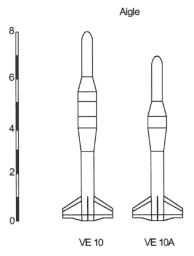

The MAXUS programme, which started in 1989, is the fruit of a collaboration between SSC (Sweden)
and DASA, ex-MBB/ERNO (Germany). It is a development of the microgravity experiments programmes
MASER and TEXUS, carried out by the two companies. The MAXUS payload weighs approximately 720 kg,
divided into six to eight independent modules, and the duration of nominal microgravity reaches
12 minutes and 40 seconds.

The vehicle used for these experiments measures 15.5 m high and weighs 12.3 t at takeoff; it is the largest sounding rocket successfully launched from Western Europe. This rocket is propelled by a Thiokol Castor 4B motor, 1 m in diameter, which delivers an average 450 kN thrust during 63 seconds. This version of Castor 4 is equipped with a swiveling nozzle which allows the rocket piloting.
The first flight failed in May 1991, but the payload was recovered after culminating at 154 km
of altitude. It was successfully launched again the following year, for the MAXUS-1B mission.
The second payload was launched only in 1995, third in 1998.
MAXUS program launches
| Date | Site | Vehicle | Mission | Results |
|---|---|---|---|---|
| 08 May 1991 | KIR | Castor 4B | MAXUS 1 | EV (154 km) |
| 08 Nov 1992 | KIR | Castor 4B | MAXUS 1B | S (717 km) |
| 29 Nov 1995 | KIR | Castor 4B | MAXUS 2 | S (706 km) |
| 24 Nov 1998 | KIR | Castor 4B | MAXUS 3 | S (713 km) |
| 09 Apr 2001 | KIR | Castor 4B | MAXUS 4 | S |
External resources
Swedish Space Corp. - Maxus